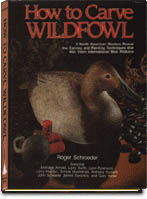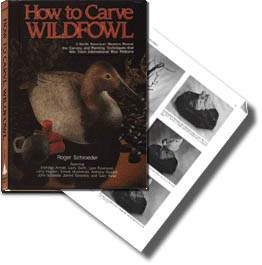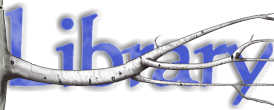Stackpole Books Presents
How
to Carve Wildfowl
 by Roger
Schroeder
Featuring
by Roger
Schroeder
Featuring
Eldridge Arnold, Larry
Barth, Lynn Forehand,
Larry Hayden, Ernest Muehlmatt, Anthony
Rudisill,
John Scheeler, James Sprankle, and Gary
Yoder
* 800
black and white photographs
*16 full
pages of color
"If you have ever
dreamed of carving a decoy or winning a blue ribbon
in wildfowl competition, open the pages of HOW TO
CARVE WILDFOWL. Sit down with 9 of todays most
respected, most talented, and most honored carvers
of decoys and gamebirds.
Roger Schroeder.
himself a master of fine woodworking, has selected
the top blue-ribbon winners to feature in this
definitive book on the art and craft of wild bird
sculpting.
With Schroeder as
your guide, travel to the workshop of each master.
Learn firsthand from them the secrets that have
earned them the coveted ribbons of the world's most
prestigious competitions.
Schroeder takes you
first to visit Lynn Forehand in Chesapeake,
Virginia, as the artist begins to carve a miniature
pheasant. Through masterful step-by-step
photographs, you peer over Forehand's shoulder and
see him progress from the drawing board to the
block of basswood. Forehand shares his techniques
for roughing out the piece, shaping with the
Foredom tool, rotating the head, burning-in lines,
and laying out and detailing feathers. You'll
follow along until the pheasant is ready for
painting.
 Next you'll pull
up a chair in the workshop of Ernest Muehlmatt in
Springfield, Pennsylvania. He's working on two
pieces: a woodcock and a spruce grouse. Discover
how Muehlmatt so deftly uses the burning pen to
achieve colors in wood, a technique he's perfected
that is especially suited to earth tones of the
woodcock and grouse. Learn how Muehlmatt gives his
birds a fluid look with muscles and bumps, how he
creates a weIl-designed arrangement, and how he
blends the elements together. Before you leave,
Muehlmatt reveals what he's learned about the
importance of color, mixes, and washes. Next you'll pull
up a chair in the workshop of Ernest Muehlmatt in
Springfield, Pennsylvania. He's working on two
pieces: a woodcock and a spruce grouse. Discover
how Muehlmatt so deftly uses the burning pen to
achieve colors in wood, a technique he's perfected
that is especially suited to earth tones of the
woodcock and grouse. Learn how Muehlmatt gives his
birds a fluid look with muscles and bumps, how he
creates a weIl-designed arrangement, and how he
blends the elements together. Before you leave,
Muehlmatt reveals what he's learned about the
importance of color, mixes, and washes.
Next stop is
Eldridge Arnold's studio in Greenwich, Connecticut.
As he sculpts and paints a woodcock, he shows you
how to make and insert separate wings, feathers,
and tails. Discover why he pays special attention
to the sculpture's base and how he achieves more by
actually painting less.
Then on to May's
Landing, New Jersey, where you'll visit John
Scheeler. Watch him start with only a band-sawed
side profile and a center line and move into
composing, shaping, and sculpting. As he inserts
wings, he reveals his special technique for getting
a contoured look and talks about the ways he
sculpts the birds of prey he's partial to.
Then drop in on
Anthony Rudisill in West Atlantic City, New Jersey.
You eavesdrop as Rudisill creates a kingfisher. You
learn how he works with a mount, uses a pattern,
seams the head, and makes clever use of a roofing
nail. Pay special attention to how Rudisill secures
a support system and why he's so particular about
the base.
In Larry Barth's
studio in Stahlstown, Pennsylvania, you encounter
the fresh creativity he brings to the loons he's
working on. He shares with you his insights on the
composition and on the relationship of a bird to
the structural elements in nature. Learning how he
works from a clay model and how he looks at birds
in flight are special highlights of your
visit.
Gary Yoder of
Grantsville, Maryland. Is sketching a pair of
miniature pheasants when you arrive. First he tells
you how he meets the challenges of implied motion
through shaping and assembly. Then he demonstrates
texturing in the making of feathers. Remember to
observe how he uses a grinding stone to enhance his
birds.
On to Annapolis,
Maryland, to see James Sprankle in his aviary. As
he carves and paints a shoveler, he reveals some
personally developed techniques for smoothing
carved wood, flaring a head into the body, making
Corrections in pose, blending paints, and
texturing.
Your trip isn't
complete until you've traveled to see Larry Hayden
in Farmington Hills, Michigan. He's working on a
canvasback, and he shares the secrets he's
developed for carving decoys. He brings out the
subtleties involved in carving a head, and he
discloses what he's learned about the importance of
the eye position and how he works to attain a soft
yet animated carving by using a grinding stone. The
visit ends with a detailed session on how to
prepare a decoy for painting, with a special
concentration on color and the intricacies of
painting.
You've done it.
You've visited 9 of the top wildfowl carvers in
North America. You've marveled at their excellence
and learned from the skill they've demonstrated.
Now you're eager to put blade and brush to wood,
try the techniques you've been studying, and create
a masterpiece of your own."
9 North
American Masters Reveal the Carving and Painting
Techniques That Win Them International Blue
Ribbons
ABOUT THE AUTHOR
Roger Schroeder is
an accomplished woodworker, carver, photographer,
and writer. He has co-authored Woodcarving
Illustrated and Timber Frame Construction. His many
woodworking articles, dealing with such subjects as
carousel horses, wooden locks, post-and-beam
houses, and furniture design, have appeared In Fine
Woodworking, Woodworker's Journal, and Fine Home
building. When he is not writing or building
furniture, you may find him playing tennis or surf
fishing.
A teacher of high
school English, Roger Schroeder lives in
Amityville, New York.
For a complete list
of Stackpole Books, write:
Stackpole Books
5067
Ritter Road
Mechanicsburg, PA
17055
Or call:
1 800 233-9015
|


